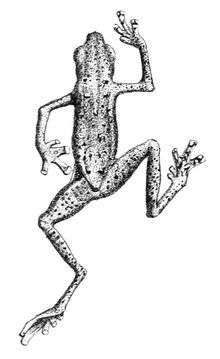Pelophryne
Pelophryne, commonly known as flathead toads or dwarf toads, is a genus of true toads, family Bufonidae.[1][2] The genus occurs in the Philippines, Borneo, Malaya including Singapore, and Hainan (China). Molecular data suggest that Pelophryne is the sister taxon of Ansonia.[1]
| Pelophryne | |
|---|---|
 | |
| Pelophryne guentheri | |
| Scientific classification | |
| Kingdom: | Animalia |
| Phylum: | Chordata |
| Class: | Amphibia |
| Order: | Anura |
| Family: | Bufonidae |
| Genus: | Pelophryne Barbour, 1938 |
| Type species | |
| Pelophryne albotaeniata Barbour, 1938 | |
| Species | |
|
See table. | |
Description and ecology
Pelophryne are small, semi-arboreal toads. They can easily be recognized by the peculiar, fleshy web of their fingers and toes. The genus can be divided into two groups: one with rounded but not expanded finger tips, and the other with the tips of the fingers expanded into truncate discs. This morphological division is supported by molecular data.[3]
Where two Pelophryne species coexist, one species is small (<20 mm (0.8 in)) and the other one is larger, about 25–28 mm (1.0–1.1 in) in snout–vent length. This is suggestive of resource partitioning.[3]
The tadpoles are specialized for rapid development in very small rain water pools. The eggs are relatively large, and the tadpoles appear to subsist the larval period on yolk. The tadpoles have a degenerate oral disk and lack a spiracle.[4][5]
Species
The following species are recognized in the genus Pelophryne:[1]
| Binomial name and author | Common name |
|---|---|
| Pelophryne albotaeniata Barbour, 1938 | White-striped flathead toad |
| Pelophryne api Dring, 1984 | |
| Pelophryne brevipes (Peters, 1867) | Zamboanga flathead toad |
| Pelophryne guentheri (Boulenger, 1882) | Gunther's flathead toad |
| Pelophryne ingeri Matsui, 2019) | |
| Pelophryne lighti (Taylor, 1920) | Mindanao flathead toad |
| Pelophryne linanitensis Das, 2008[6] | |
| Pelophryne misera (Mocquard, 1890) | Black flathead toad |
| Pelophryne murudensis Das, 2008[6] | |
| Pelophryne penrissenensis Matsui, Nishikawa, Eto, and Hossman, 2017[3] | |
| Pelophryne rhopophilius Inger and Stuebing, 1996 | |
| Pelophryne saravacensis Inger and Stuebing, 2009 | |
| Pelophryne signata (Boulenger, 1895) | Saint Andrew's cross toadlet |
In addition, the AmphibiaWeb recognizes Pelophryne macrotis as distinct from Pelophryne guentheri.[2]
References
- Frost, Darrel R. (2018). "Pelophryne Barbour, 1938". Amphibian Species of the World: an Online Reference. Version 6.0. American Museum of Natural History. Retrieved 23 April 2018.
- "Bufonidae". AmphibiaWeb. University of California, Berkeley. 2018. Retrieved 23 April 2018.
- Matsui, Masafumi; Nishikawa, Kanto; Eto, Koshiro & Hossman, Mohamad Yazid Bin (2017). "A new species of Pelophryne from western Sarawak, Malaysian Borneo (Anura, Bufonidae)". Zoological Science. 34 (4): 345–350. doi:10.2108/zs170008.
- Inger, Robert F. (1960). "Notes on toads of the genus Pelophryne". Fieldiana Zoology. 39 (39): 415–418.
- Inger, Robert F. (1960). "A review of the oriental toads of the genus Ansonia Stoliczka". Fieldiana Zoology. 39 (43): 473–503.
- Das, I. 2008. "Two new species of Pelophryne (Anura: Bufoidae) from Gunung Murud, Sarawak (Northwestern Borneo)" (PDF). The Raffles Bulletin of Zoology 56(2): 435–443.
External links
- eol - Encyclopedia of Life taxon Pelophryne at http://www.eol.org.
- ITIS - Integrated Taxonomic Information System on-line database Taxon Pelophryne at https://www.itis.gov/index.html. (Accessed: May 7, 2008).
- GBIF - Global Biodiversity Information Facility Taxon Pelophryne at http://data.gbif.org/welcome.htm
| Wikispecies has information related to Pelophryne |